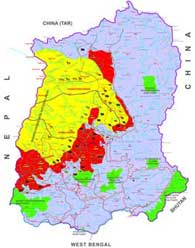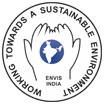
|
Protected AreasIndia has at present four categories of protected area (PAs), these are National Parks, Sanctuaries, Conservation Reserves and Community Reserves which are provided legal sanctity by the Wildlife (Protection) Act 1972. However, there area six categories specified by the IUCN (International Union for Conservation of Nature) and different countries have different categories of PAs as per their requirements and norms laid by their Governments. Current Figure of Protected Areas in India (As on December 2021)
|

|
||||||||||||||||||||||||||||||||||||||||||||||||||||||||||||||||||||||||||||||||||||||||||||||||||||||||||||||||||||||||||||||||||||||||||||||||||||||||||||||||||||
|
Wildlife Protected Areas of Sikkim In Sikkim we have, presently, 9 Protected Areas which comprises of 1 National Park and 7 Wildlife Sanctuaries and 1 Conservation Reserve that covers 30.77 per cent of the total geographical area of the state.
1. Protected Area Network including KBR = 3330.28 Sq Km i.e 46.93% of States Geographical Area. 2. Total area under administration by Forests, Environment & Wildlife Management Department (RF i/c PAs) + Khasmals + Gaucharan =5452+285+104=5841 Sq km) 3. Territorial Sector [RF + Khasmals + Gaucharan = 3268.90 + 285 +104 = 3657.90 Sq. km] i.e. 51.55% of State's Geographical area 4. Wildlife Sector [KNP + Sanctuaries + Conservation Reserve = 2183.70 Sq. km] i.e. 30.77 % of State's Geographical Area. [Top] Conservation Zones
Guidelines for Dispensing Compensation for Life/ Property/ Losses during Human Wildlife Conflict - Sikkim Forest, Environment & Wildlife Management Deaparment, Government of Sikkim has formulated guidelines for speedy and effective implementation of dispensing compensation to the victims or next kin for life/ property/ losses incurred during the human-wildlife conflict in the State of Sikkim vide F.No. 261/WLC/F/06/194 dated 26/12/2015. » See the Guidlelines [PDF: 203 Kb] [Top]Prespective Manaagement Strategies of WPAs of Sikkim 2009 The term wildlife encompasses all uncultivated flora and undomesticated fauna. Every species has the right to live and every threatened species must be protected to prevent extinction. Water, wilderness and wildlife are irrevocably interlinked. With mounting industrial and demographic pressures, wilderness areas, which are the richest repositories of wildlife and biodiversity have either shrunk or disappeared their continued existence is crucial for the long term survival of the biodiversity and the ecosystems supporting them. Effective ecosystem conservation is the foundation of long-term ecological and economic stability. Conservation of biodiversity is directly linked with conservation of ecosystems and thus with water and food security. Habitat loss caused by developmental infrastructural developmental projects for short term economic gains undermining ecological security. Read More [Top] |
|||||||||||||||||||||||||||||||||||||||||||||||||||||||||||||||||||||||||||||||||||||||||||||||||||||||||||||||||||||||||||||||||||||||||||||||||||||||||||||||||||||


.jpg) Poster depicting the negative effects of feeding monkeys. It is an appeal to the general public to refrain
from feeding monkeys since such actions are the cause of increasing incidence of Monkey Menace in the State.
Poster depicting the negative effects of feeding monkeys. It is an appeal to the general public to refrain
from feeding monkeys since such actions are the cause of increasing incidence of Monkey Menace in the State. People's opinion on the impact of
"Ban of Grazing" on Barsey Rhododendron Sanctuary
People's opinion on the impact of
"Ban of Grazing" on Barsey Rhododendron Sanctuary File Index of Wildlife East Divsion / North and East Wildlife FDA
File Index of Wildlife East Divsion / North and East Wildlife FDA